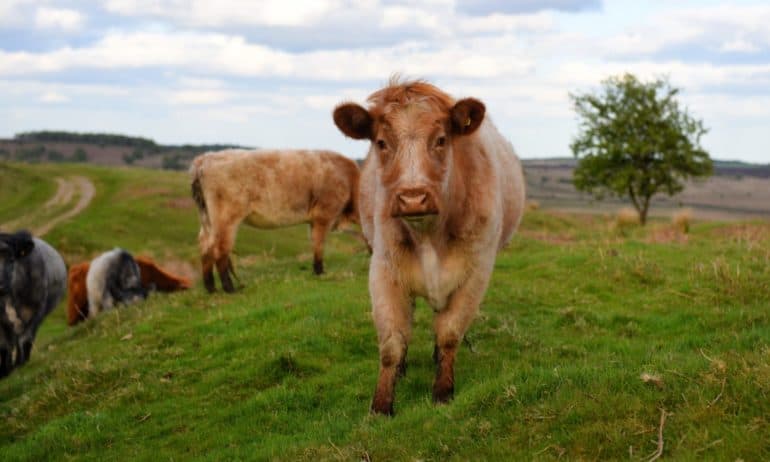Is grass-fed beef good or bad for the climate? That’s the question examined in a major report released this week by the University of Oxford’s Food Climate Research Network (FCRN). While “Grazed and Confused” intended to reduce confusion about the climate merits of pasture-based meat, the report’s narrow focus on the net climate impacts of grass-fed meat has instead muddied the waters.
That’s because one of the report’s main conclusions—”Eating less meat, of all types, is critical for fighting climate change”—fails to account for the many environmental, animal welfare, and health benefits of well-managed, pasture-raised animals. The report’s message also undercuts the urgent need to expand support for pasture-based and mixed crop-livestock systems as vital alternatives to the industrial meat industry’s inhumane and environmentally destructive practices, including reliance on toxic, chemical-intensive GMO monocultures for feed.
The authors base their conclusion on their finding that the carbon sequestration gains of even well-managed grazing systems are eclipsed by these farms’ methane and nitrous oxide emissions. We agree that reducing meat consumption is key to combating climate change. But does that mean we should focus on eating less grass-fed meat or reducing investment and support for farmers that adopt these kinds of production systems?
No. Since more than 95 percent of the beef consumed in the United States comes from animals raised on polluting, inhumane factory farms, we should focus first on slashing consumption—and subsidies for the production of industrial animal products. We also need to significantly increase consumption of and investment in plant-based protein foods. Research shows the world cannot meet greenhouse gas reduction targets without drastically cutting emissions from our meat and dairy-intensive diets. And most of that reduction must come from the global West and North—especially in the U.S., where we eat more meat per person than any other major country in the world.
Grass-fed benefits go beyond climate
Grass-fed beef is not a silver bullet for climate-conscious carnivores. But for those who do eat meat, eating smaller portions of meat that is produced by well-managed, certified grass-fed, and organic farms has other benefits for the well-being of animals, pollinators, public health, biodiversity, our soils, air, and water.
In contrast to industrial feedlots that generate massive air, soil, and water pollution from feed production and toxic concentrated livestock waste, well-managed pastures and rangeland can turn manure into organic nourishment for soils and crops. These systems can also provide critical habitat for pollinators and other wildlife, and can bolster resilience to the severe droughts and flooding created by climate change, by enriching soils to improve water absorption and holding capacity. When accounting for carbon sequestration in soils, several studies have found that some U.S. pasture-based and grazing systems produce a smaller carbon footprint than industrial confinement systems. When regenerative practices like composting are implemented on grazing lands, the results can be spectacular. For example, Marin Carbon Project found that if just five percent of California’s grazed grasslands were covered with compost, this would sequester 28 million tons of carbon from the atmosphere—equivalent to the annual emissions of 6 million cars.
Pasture-based and organic meat production is also far better for public health. While feedlot animals receive routine doses of antibiotics and are often injected with hormones and other growth promoters that can harm animal welfare and human health, organic and certified grass-fed livestock are almost always raised without hormones and routine antibiotics. This reduces the spread of antibiotic-resistant bacteria in humans—a major public health concern. Grass-fed meat also has higher levels of nutrients, including Omega-3 fats, beta-carotene, conjugated linoleic acid, and Vitamin E, than grain-fed beef, according to several studies.
FCRN’s report argues that grass-fed beef is not the ultimate solution to climate change. We agree. But as we reduce our overall meat consumption, switching to well-managed organic and pasture-raised, grass-fed meat—including mixed crop-livestock systems—can produce vital gains for our environment, our health, and animal welfare. The quickest path to these important goals is to shift consumption and subsidies away from the disastrous, corporate-controlled, concentrated animal feeding operations (CAFOs), and monoculture feed production which cause immense harm to the environment, farmers, and consumers.
Institutional purchasers must lead the change
To benefit our climate and public health, Friends of the Earth has launched the Better Burgers Campaign. This initiative helps consumers and food service professionals cut their climate impact by making and consuming smaller portions of better meat, putting vegetables and legumes at the center of the plate (as Menus of Change recommends), and making delicious blended burgers. Blended burgers replace 30 to 50 percent of the meat with mushrooms, legumes, or other veggies. Using less meat shrinks a burger’s carbon footprint considerably—and the money saved by using less meat can purchase better-quality, third-party certified animal and plant-based foods produced locally and regionally using ecological farming methods. With nearly half of our food dollars spent outside the home, restaurants, schools, government institutions, hospitals, and businesses can put a big dent in climate change by serving more plant-based foods and downsizing meat portions through innovative recipes, such as the blended burger.
More research needed
While the FCRN report provides new information on grass-fed meat and climate change, we need more research to determine which systems, under which conditions, can sequester the most carbon and minimize methane releases. Given the dramatic variations of grazing systems around the world, and the potential of silvopasture and other management practices to deliver significant climate benefits, we still have much to learn. We also need more holistic research to better understand the wide-ranging benefits of pasture-raised and organic grass-fed systems—and the most effective strategies for swiftly moving our society to reduce overall meat consumption. While we don’t have all the answers yet, it’s abundantly clear we have viable alternatives that can nourish consumers’ health and our imperiled environment. We can go a long way in that direction by shifting public policy and institutional purchasing to help people shift to protein sources—from both plants and animals—that are better for our bodies and for the planet.













